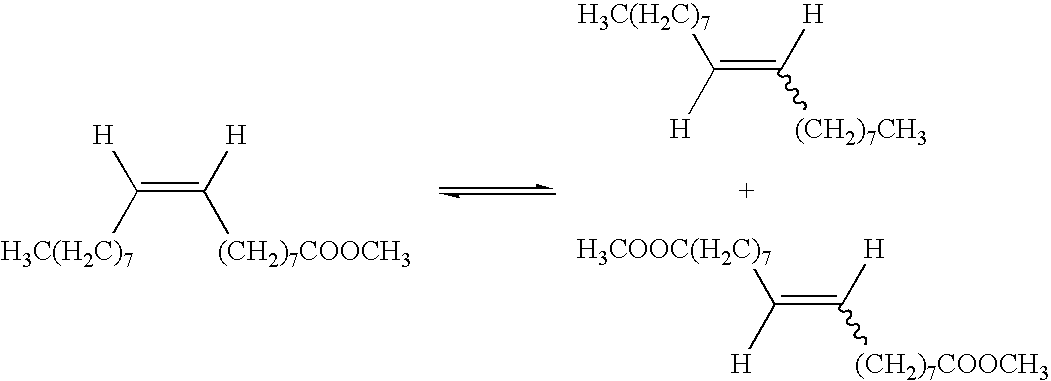Process for co-producing olefins and diesters or diacids by homomethathesis of unsaturated fats in non-aqueous ionic liquids
a technology of unsaturated fats and olefins, which is applied in the preparation of carboxylic compounds, hydrocarbon preparation catalysts, fatty acid chemical modifications, etc., can solve the problems of contaminating reaction products, poor compatibility with functional groups such as acids or esters, low activity and rapid deactivation of such catalytic systems
- Summary
- Abstract
- Description
- Claims
- Application Information
AI Technical Summary
Problems solved by technology
Method used
Image
Examples
example 1
[0108] Biphasic Homometathesis of Methyl Oleate in Ionic Liquid
[0109] To a glass reaction flask were added (30 mg, 0.036 mmol, 0.004 eq.) benzylidene-bis(tricyclohexylphosphine)dichlororuthenium, (3mL, 8.84 mmol, 1 eq.) methyl oleate, 1 mL 1-butyl-1-methylpyrrolidinium bisttrifluoromethanesulfonyl)amide with formula [BMPyrr] [NTf2], 2 mL heptane and 0.1 mL of dodecane as internal standard. The mixture was biphasic. It was stirred and heated at 55° C. After 2 hours reaction time, a small aliquot of the liquid upper phase was removed for FID GC analysis. GC analysis indicated that the metathesis reaction had proceeded cleanly, yielding 9-octadecene and dimethyloctadecene-1,18-dioate products. Conversion of methyl oleate to these products was 46 wt %.
example 2
[0110] Recycling Experiments.
[0111] To a glass reaction flask were added (50 mg, 0.059 mmol, 0.01 eq,) (1,3-Bis-(2,4,6-trimethylphenyl)-2-imidazolidinylidene) dichloro(benzylidene)(tricyclohexylphosphine) ruthenium, (1.5 mL, 4.42 mmol, 1 eq.) methyl oleate, 1 mL 1-butyl-1-methylpyrrolidinium bis(trifluoromethanesulfonyl)amide, 2 mL heptane and 0.1 mL of dodecane as internal standard. The mixture was biphasic. It was stirred at room temperature After 2 hours reaction time, the mixture was decanted. The upper layer was removed and the resulting ionic liquid solution was washed with 2 mL of heptane. A small aliquot of the combined organic liquid was analyzed by GC (entry 1). Fresh methyl oleate (1.5 mL, 4.42 mmol, 1 eq.), 2 mL of heptane and 0.1 mL of dodecane were added to the ionic liquid after each recycle and reaction was allowed to restart at room temperature. GC analysis indicated that the metathesis reaction had proceeded yielding mainly 9-octadecene and dimethyloctadecene-1,18...
PUM
| Property | Measurement | Unit |
|---|---|---|
| Temperature | aaaaa | aaaaa |
| Fraction | aaaaa | aaaaa |
| Fraction | aaaaa | aaaaa |
Abstract
Description
Claims
Application Information
 Login to View More
Login to View More - R&D
- Intellectual Property
- Life Sciences
- Materials
- Tech Scout
- Unparalleled Data Quality
- Higher Quality Content
- 60% Fewer Hallucinations
Browse by: Latest US Patents, China's latest patents, Technical Efficacy Thesaurus, Application Domain, Technology Topic, Popular Technical Reports.
© 2025 PatSnap. All rights reserved.Legal|Privacy policy|Modern Slavery Act Transparency Statement|Sitemap|About US| Contact US: help@patsnap.com



